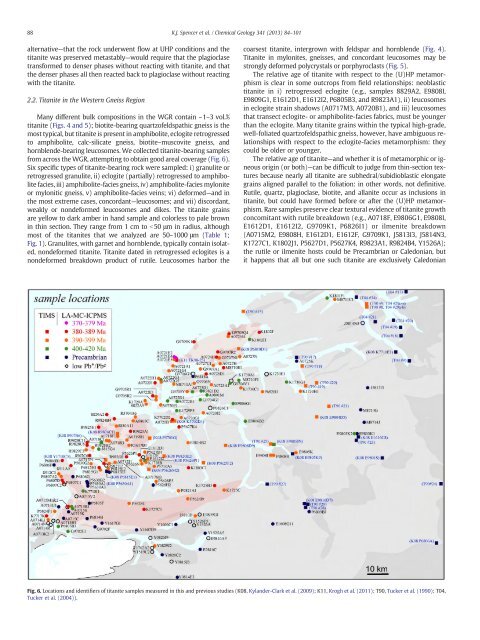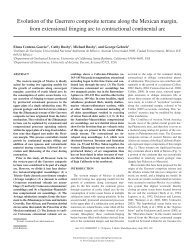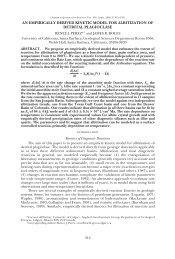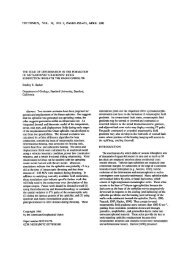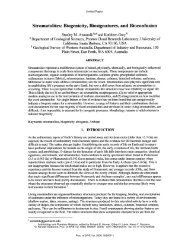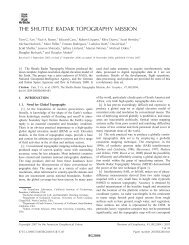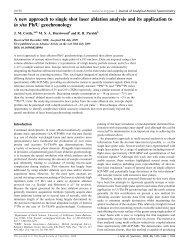Campaign-style titanite U-Pb dating by ICP - Earth Science ...
Campaign-style titanite U-Pb dating by ICP - Earth Science ...
Campaign-style titanite U-Pb dating by ICP - Earth Science ...
Create successful ePaper yourself
Turn your PDF publications into a flip-book with our unique Google optimized e-Paper software.
88 K.J. Spencer et al. / Chemical Geology 341 (2013) 84–101alternative—that the rock underwent flow at UHP conditions and the<strong>titanite</strong> was preserved metastably—would require that the plagioclasetransformed to denser phases without reacting with <strong>titanite</strong>, and thatthe denser phases all then reacted back to plagioclase without reactingwith the <strong>titanite</strong>.2.2. Titanite in the Western Gneiss RegionMany different bulk compositions in the WGR contain ~1–3 vol.%<strong>titanite</strong> (Figs. 4 and 5); biotite-bearing quartzofeldspathic gneiss is themost typical, but <strong>titanite</strong> is present in amphibolite, eclogite retrogressedto amphibolite, calc-silicate gneiss, biotite–muscovite gneiss, andhornblende-bearing leucosomes. We collected <strong>titanite</strong>-bearing samplesfrom across the WGR, attempting to obtain good areal coverage (Fig. 6).Six specific types of <strong>titanite</strong>-bearing rock were sampled: i) granulite orretrogressed granulite, ii) eclogite (partially) retrogressed to amphibolitefacies, iii) amphibolite-facies gneiss, iv) amphibolite-facies myloniteor mylonitic gneiss, v) amphibolite-facies veins; vi) deformed—and inthe most extreme cases, concordant—leucosomes; and vii) discordant,weakly or nondeformed leucosomes and dikes. The <strong>titanite</strong> grainsare yellow to dark amber in hand sample and colorless to pale brownin thin section. They range from 1 cm to b50 μm in radius, althoughmost of the <strong>titanite</strong>s that we analyzed are 50–1000 μm (Table 1;Fig. 1). Granulites, with garnet and hornblende, typically contain isolated,nondeformed <strong>titanite</strong>. Titanite dated in retrogressed eclogites is anondeformed breakdown product of rutile. Leucosomes harbor thecoarsest <strong>titanite</strong>, intergrown with feldspar and hornblende (Fig. 4).Titanite in mylonites, gneisses, and concordant leucosomes may bestrongly deformed polycrystals or porphyroclasts (Fig. 5).The relative age of <strong>titanite</strong> with respect to the (U)HP metamorphismis clear in some outcrops from field relationships: neoblastic<strong>titanite</strong> in i) retrogressed eclogite (e.g., samples 8829A2, E9808I,E9809G1, E1612D1, E1612I2, P6805B3, and R9823A1), ii) leucosomesin eclogite strain shadows (A0717M3, A0720B1), and iii) leucosomesthat transect eclogite- or amphibolite-facies fabrics, must be youngerthan the eclogite. Many <strong>titanite</strong> grains within the typical high-grade,well-foliated quartzofeldspathic gneiss, however, have ambiguous relationshipswith respect to the eclogite-facies metamorphism: theycould be older or younger.The relative age of <strong>titanite</strong>—and whether it is of metamorphic or igneousorigin (or both)—can be difficult to judge from thin-section texturesbecause nearly all <strong>titanite</strong> are subhedral/subidioblastic elongategrains aligned parallel to the foliation: in other words, not definitive.Rutile, quartz, plagioclase, biotite, and allanite occur as inclusions in<strong>titanite</strong>, but could have formed before or after the (U)HP metamorphism.Rare samples preserve clear textural evidence of <strong>titanite</strong> growthconcomitant with rutile breakdown (e.g., A0718F, E9806G1, E9808I,E1612D1, E1612I2, G9709K1, P6826I1) or ilmenite breakdown(A0715M2, E9808H, E1612D1, E1612F, G9709K1, J5813I3, J5814N3,K1727C1, K1802J1, P5627D1, P5627K4, R9823A1, R9824B4, Y1526A);the rutile or ilmenite hosts could be Precambrian or Caledonian, butit happens that all but one such <strong>titanite</strong> are exclusively CaledonianFig. 6. Locations and identifiers of <strong>titanite</strong> samples measured in this and previous studies (K08, Kylander-Clark et al. (2009); K11, Krogh et al. (2011); T90, Tucker et al. (1990); T04,Tucker et al. (2004)).


